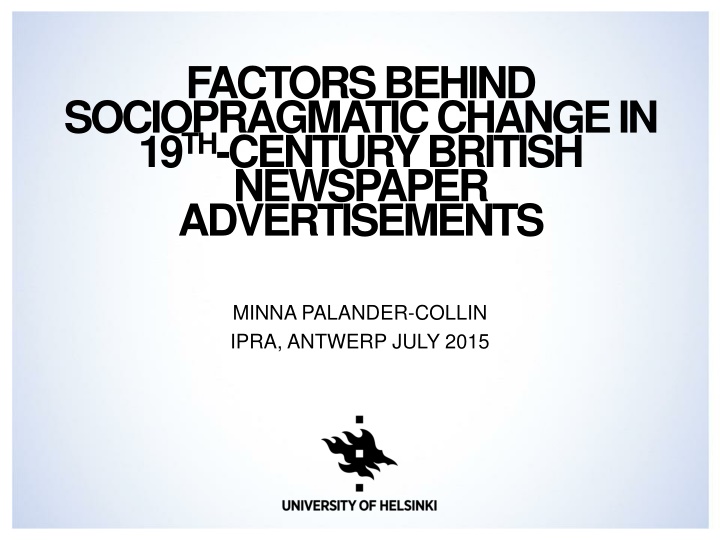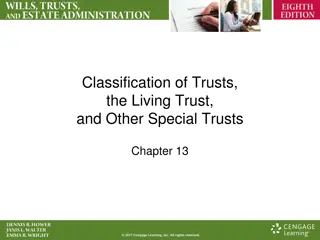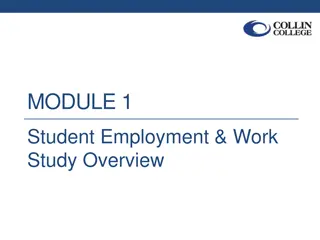
Factors Driving Sociopragmatic Change in 19th-Century British Newspaper Ads
Explore the sociopragmatic changes in 19th-century British newspaper advertisements, focusing on decreasing person-mention, themes of politeness, audience engagement, and advertiser practices. The study delves into the evolving dynamics of interpersonal communication in advertisements during this period.
Download Presentation

Please find below an Image/Link to download the presentation.
The content on the website is provided AS IS for your information and personal use only. It may not be sold, licensed, or shared on other websites without obtaining consent from the author. If you encounter any issues during the download, it is possible that the publisher has removed the file from their server.
You are allowed to download the files provided on this website for personal or commercial use, subject to the condition that they are used lawfully. All files are the property of their respective owners.
The content on the website is provided AS IS for your information and personal use only. It may not be sold, licensed, or shared on other websites without obtaining consent from the author.
E N D
Presentation Transcript
FACTORS BEHIND SOCIOPRAGMATICCHANGE IN 19TH-CENTURY BRITISH NEWSPAPER ADVERTISEMENTS MINNA PALANDER-COLLIN IPRA, ANTWERP JULY 2015
THEMES 19TH-CENTURY CHANGE IN ADVERTISEMENTS: DECREASING PERSON-MENTION ADVERTISEMENTS IN SOCIO-CULTURAL CONTEXT: DOMAIN THEORY ADVERTISEMENTS AND 19TH-CENTURY DEVELOPMENTS IN POLITENESS
ADVERTISEMENTS1785- 1880 The Times Aug 1805 The Times Jan 1880 3
ADVERTISEMENTS1785- 1880 Advertiser Other people Audience The Times, Aug 1805 The Times, Jan 1880 4
DECREASINGPERSON- MENTIONIN ADS 5
AUDIENCE-MENTION Average audience-mention per ad 4 3.5 3 2.5 2 1.5 1 0.5 0 1785 1805 1815 1835 1855 1880 Audience Times Audience Morning Post 6
ADVERTISER Proportion of ads with advertiser only 70% 60% 50% 40% 30% 20% 10% 0% 1785 1805 1815 1835 1855 1880 AD Times AD Morning Post 7
ADVERTISER+ AUDIENCE Proportion of ads with advertiser and audience mention 60% 50% 40% 30% 20% 10% 0% 1785 1805 1815 1835 1855 1880 AD+ AU Times AD+ AU Morning Post 8
INTERPERSONAL WORK IN ADS WITHPERSON- MENTION The advertiser s deferential politeness towards the audience especially in the opening phrases of the advertisement but also later in the body text, intentions to inform, serve, thank customers for their support, make them promises of good service in the future the advertiser most respectfully informs, begs leave to inform or acquaint the audience the advertiser has an informative purpose in the communication and needs to ask permission to approach the audience a narrative structure with verbs in the past to describe actions performed in the acquisition or making of the commodity being sold -> quarantee of quality 9
SOCIALRELATIONSAS SOCIALCAPITAL IN ADS Advertising depends on the social acceptance of its products by various stakeholder groups, such as consumers, business partners and critics in media and civil society. The acceptance of an entire industry and its social consequences is greatly facilitated if the main proponents of the industry in question are seen to come from respected social backgrounds and are socially connected to other individuals with trusted biographies . These inter-personal connections are a form of social capital accumulated through a process whereby social assets such as respect, confidence and loyalty are imparted through institutions including family, schooling and official organisations. (Schwarzkopf 2008: 182) 10
SOCIOCULTURAL CONTEXTOF ADS Advertisement Social relations power practices Situated activity Advertiser- Audience;Genre styles and models; local circumstances and practices Contextual resources dominant values, distribution of wealth, education Settings Practices of advertising and newspaper business Psychobiography Purpose of advertiser Based on Layder s (1997: 78) social domains 11
SOCIOCULTURAL CONTEXTOF ADS Advertisement Social relations power practices Contextual resources Population growth, industrialization, urbanization, democratization, individualism, increasing literacy, widening readership, changing commercial market and commodity culture Settings Increase in newspaper production; financial importance of ads; Mid-19th century abolition of taxes on newspapers and advertisements Situated activity Needs and attitudes of discourse communities; textual models available; regulation vs innovation Psychobiography (1) Attract attention, (2) arouse interest, (3) stimulate desire, (4) create conviction, (5) get action 12
19TH-CENTURY ENGLISH POLITENESS 18th-century politeness as compliment culture (Jucker 2012) non-imposition negative politeness in English developed in the 19th century in the framework of broader ideological and societal developments (Culpeper & Demmen 2012) Emergence of indirect directives can you, could you Do the 19th-century developments in advertising styles tell the same story of developing non-imposition negative politeness? Advertising discourses: Relation between the advertiser and the consumer (in third person) No (overt) personal relation (YOU) 13
19TH-CENTURY SOCIO- CULTURAL-PRAGMATIC DEVELOPMENTS idea of self; individual vs. society power of middle classes; emergence of working classes population growth and urbanization social and geographical mobility These developments favoured the emergence of non-imposition negative politeness strategies As well as the absence of (networks of) persons in advertisements (e.g. Baumeister 1987, Cannadine 1998, Culpeper & Demmen 2012, Jucker 2012, Woods 1995) LOOSE-KNIT NETWORKS 14
FACEWORKIN INTERACTION Politeness (in excess) Social (verbal) interaction Interaction order (Politic) facework Impoliteness (below bar) (Bax & K d r 2012: 16)

















